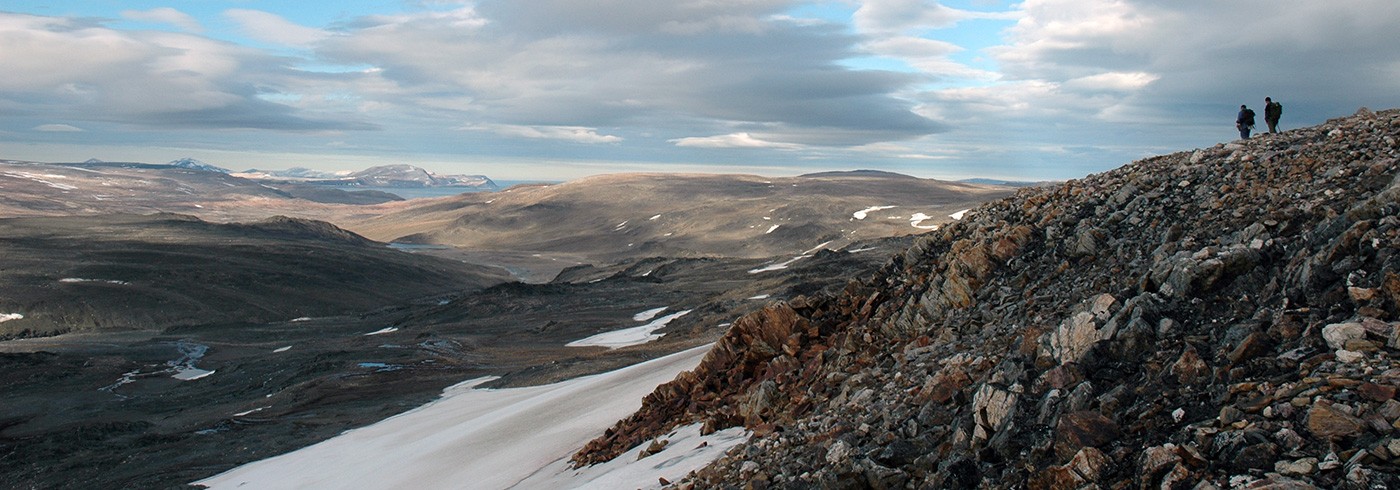Svalbard’s Caledonian Terranes revisited, Nordaustlandet 2007
1 August 2007 - 31 August 2007
Quartzites of the Murchisonfjorden supergroup (foreground) unconformably overlie volcanics of the Svartrabbane group (below snowfield). At least the latter are involved in the migmatisation. Photo: Henning Lorenz.
Between 1990 and 1998 international geoscientific expeditions to northernmost Svalbard have been carried out with the logistic support of the Swedish Polar Research Secretariat within the framework of the SWEDARCTIC programme. During this period, scientists from the Polar Marine Geosurvey Expedition in Lomonosov, Russia, have participated in these expeditions establishing a longterm collaboration that has resulted in a considerable number of joint-publications. The aim of this work was to gather knowledge about the Precambrian and Caledonian tectonic evolution of Svalbard’s eastern terranes and to establish their relationships to each other, to Greenland and other parts of the Eurasian High Arctic. One fundamental result was the finding that the Caledonian deformation and metamorphism influenced the Nordaustlandet Terrane’s late Grenville age (ca 950 Ma) basement and the unconformably overlying Neoproterozoic sedimentary successions. The intensity of this overprint increases eastwards towards Kvitøya, the archipelago’s easternmost island. Together with the evidence of the close correlation of the eastern Svalbard terranes with the East Greenland nappes, this indicates that the main Caledonian suture is located offshore, east of the Svalbard Archipelago.
In the late 1990s, the focus of our research moved eastwards, and the expeditions visited key areas in the Timanides, polar Urals, Taymyr, Severnaya Zemlya and Novaya Zemlya. But after almost a decade central Nordaustlandet was revisited in order to investigate one of the remaining major geological enigmas of this area: the migmatite complex of central Nordaustlandet in innermost Duvefjorden, and the timing of intrusive episodes in the area. This time the Swedish group was invited to join the Russian operations, whose many field parties covered large areas of northern Svalbard for regional geological mapping in collaboration with the Norwegian Polar Institute. The Swedish Polar Research Secretariat provided equipment, weapons and weapon training for the Swedish group.
Transport from Longyearbyen was organised with the Russian helicopter on one of its regular flights to visit the Russian field parties, to move camp and supply provisions, and on 1 August the Swedish party joined the Russian camp at Innvika (picture 4). Fieldwork concentrated on the local stratigraphy of the Neoproterozoic sedimentary successions (picture 1) with the purpose to investigate how far these were affected by the different intrusive phases (picture 3) (metamorphic grade and migmatisation) and the associated deformation episodes, as well as the relationship of the intrusive rocks to each other (relative age, picture 2). Sampling for isotope age determinations of the magmatic rocks and for detrital zircons studies (sediment provenance) of the sedimentary rocks complemented the survey.
However, the early approach of the winter interfered with the helicopter schedule and when on 13 August the weather situation improved sufficiently for helicopter traffic, the Swedish field party withdrew to Longyearbyen, after visiting a selection of geological key locations in northern Nordaustlandet together with Russian colleagues.




